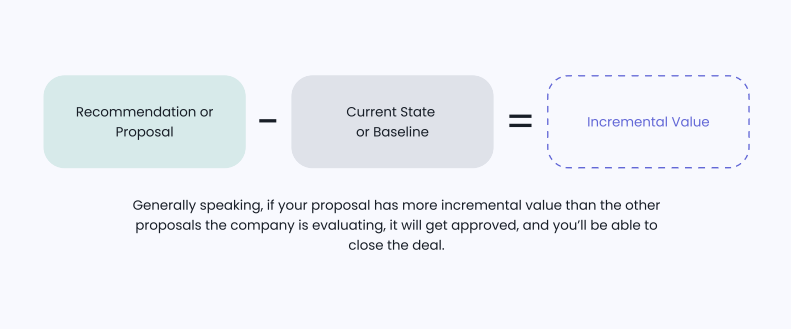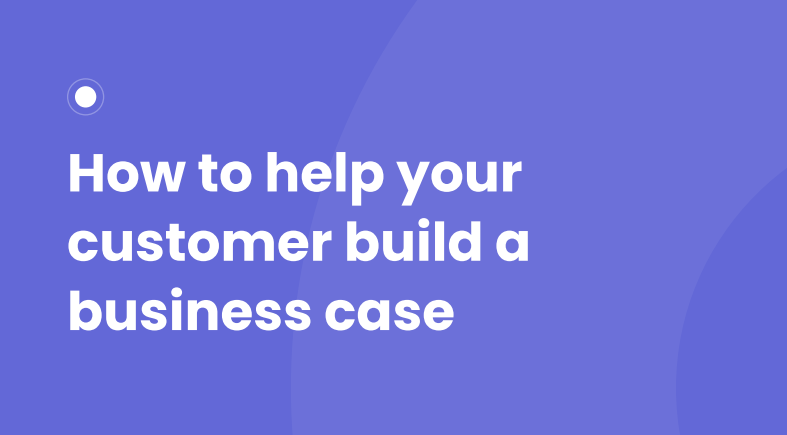First off, what is a and why is it important? business case
Let’s say you’re selling a product or service. It’s awesome, and you know it can help your target customer.You’ve even made a believer out of the person you’ve been in contact with. Unfortunately, closing the dealisn’t as simple as just convincing one person of the value – especially if what you’re selling is above acertain cost threshold.
Decisions aren’t made by a single person, especially in larger organizations. In fact, to prevent anyone andeveryone from spending the company’s money loosely, there are processes put in place to make the bestbuying decisions. Why should the company prioritize buying your product or service versus another?
Business cases help the company evaluate and compare different proposed initiatives.
A business case can be known by other names as well – like a cost benefit analysis, pro forma, or financialcase. It frequently conjures up different things to different people and companies, but commonly has thefollowing components:
- A set of sections that detail the background, scope, risks, and recommendation, minimally
- A projection or forecast of the benefits and costs over time, usually financial benefits and costs,with some comparative financial metrics like ROI and payback period to compare it to otherbusiness cases
The projection of the benefits and costs over time is the heart or core of the business case. It’s whatoutlines how much value will be realized with the proposal to buy your product or service. The more youcan quantify the value and forecast it over time, the more convincing your proposal will be. The moreconvincing or credible you are, the higher chance of winning the deal.
What are the steps to building a business case?
There are 6 key steps to building a winning business case:
- Identify value (benefit and cost) categories across the current and future state, includinMaJ How they will be modeled (financial, non-financial, qualitative), andXPJ What the drivers of those benefits and costs are
- Get assumptions data on the drivers
- Build the forecast over time
- Complete the other sections of the business case report
- Finalize and submit the business case for approval
- Once approved, close the deal!
How do you identify and communicate the value of your product or service?
When you are proposing or recommending a new product or service, you’re fundamentally convincingthem that your proposal has incrementally more value than what they’re doing now. At Qarar we represent this with the “Master Equation”.

Value can be broken down into benefits and costs. Benefits increase value, costs obviously decrease value.
There are 3 types of value:
Financial value
These are benefits and coststhat impact the financials, likepeople costs or revenue
Non-Financial value
These are benefits and coststhat can be quantified, butaren’t financial in nature, like acustomer satisfaction score oremployee engagement
Qualitative value
These are benefits and coststhat aren’t quantified orextremely difficult to quantify,like strategic benefit orenvironmental impact
Building a business case on financial value is typically going to garner the most credibility, followed bynon-financial value. Winning a deal with a business case purely based on qualitative value is going to beextremely difficult.
Let’s review the questions that you need to ask to identify what the benefits and costs are for the currentstate and future state for your business case.
Current State:
1. What business objective does your customer have a challenge solving (that your product/service cansolve)?
Examples include
- Not enough sales revenues
- Need to identify cost savings
- High cost per transaction
- Frequent penalties
2. How are they solving that problem today, if at all?
Examples include
- Staffing a lot of people
- Paying a premium for talent
- Higher non-people costs, like real estate, using vendors, paying fines, and more
3. How would you estimate or quantify these current state benefits or costs over time?
Examples include
- Number of staff to produce widgets times annual staff cost
- Widgets sold times cost per widget
Future State:
1. If the customer were to use your product or service, how would they be reaching their businessobjectives?
Examples include
- Staffing less people
- Increasing revenues
- Lower defects
2. What additional costs (like the cost of your product/service) would they need to make sure they addback in?
Examples include
- License costs
- Professional services fees
- Warranty
3. How would you estimate or quantify those future benefits and costs over time?
Examples include
- Number of licenses times the cost of a license
- One time implementation fee
- Cost of staff times reduced staff count
Once you complete Step 3 for both the current state and future state, you will then know whatassumptions data you need to gather to build the model for your business case. Some of thoseassumptions you’ll need the customer to provide or validate. You can save time and build credibility byputting in placeholder (best guess) data to estimate it and following up with them to validate yourassumptions with their own. In other words, you can improve your assumptions by collaborating with thecustomer on your business case.
For other assumptions, specifically regarding your product or service, you will need to provide them. Forexample, you will be able to estimate the product or service costs to the customer.
Building a quality business case is a collaborative effort. A platform like Qarar can guide you through thesteps above and continue building a winning business case in a fraction of the time, so you can closemore deals, faster.
Next time, we’ll cover more on how to complete the remaining 5 steps:
- Get assumptions data on the drivers
- Build the forecast over time
- Complete the other sections of the business case report
- Finalize and submit the business case for approval
- Once approved, close the deal!




.png)

.png)


